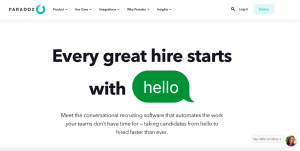
‘Quiet thriving’ is a concept that emerged after the trend ‘quiet quitting’ became widely discussed at the end of last year. Quiet quitting refers to completing the minimum requirements of one’s job. Individuals put in no additional enthusiasm, effort, time or energy than needed.
In contrast, ‘quiet thriving’ involves the opposite with employees reconsidering their relationship with work, and finding ways to re-engage and find enjoyment again, without overdoing it or burning themselves out.
A poll found that only 9 percent of UK employees currently feel engaged with their work, so if you’re looking to rediscover your love for your job, try making these small changes:
1. Shift your perspective.
A new perspective can renew your passion for your line of work and increase your productivity.
If you approach your role with a negative mindset at the start of each day, you will only be able to see the parts of the job that you dislike and will overlook the positive aspects.
Instead, try to shift your mindset and look for the beneficial parts of your position that you enjoy and give you a sense of purpose. Changing perspectives can create a greater sense of meaning in your everyday work.
For example, ‘mopping hospital floors’ could be ‘speeding up a patient’s healing journey’, connecting work to a much wider purpose and bringing greater job satisfaction.
2. Take action.
If there are responsibilities in your job that you enjoy more than others, have a discussion with your manager to see if there are ways to expand on them and discuss how to cope with the tasks you dislike.
This process is often referred to as job crafting, which is the process of an employee shaping their role to be more appealing, often with the help of a manager.
Not only can this improve your attitude toward your work, but it can also lead to further opportunities to complete tasks that you enjoy and allow your manager to better understand your strengths.
3. Set boundaries.
While being busy at work is often praised and encouraged, it can lead to employees working outside of work hours or through lunch breaks.
This will lead to burnout and build resentment towards your job. However, this can be avoided by setting clear boundaries at work to create better work-life balance.
A work time-frame agreed upon by both employee and employer is essential for job satisfaction and overall happiness.
Set clear start and finish times to stick to during the working day, whether you work standard or flexible hours, and be disciplined about not checking emails or messages outside of work hours.
This will also give you more time to enjoy other aspects of your life outside of work. In a recent survey on stress and wellbeing, 4 in 5 participants found spending time on a hobby highly effective in managing stress. Further research suggests people with some hobbies are less likely to suffer from low mood, and depression.
This is especially needed for those who feel overwhelmed by their work and ever-growing to-do lists, to recharge their batteries by doing an activity that sparks joy.
4. Build workplace relationships.
Positive relationships with your colleagues are hugely important for emotional well-being, as they can create a more relaxed and sociable environment to work in.
Co-worker interaction can help to relieve boredom from day-to-day tasks, and employees who work with friends are seven times more likely to be engaged with their job.
Interaction with colleagues during breaks and workplace socials can help to cultivate these relationships.
5. Take small breaks.
Using your lunch break and taking micro-breaks can help to improve your emotional and physical wellbeing at work.
A study found that micro-breaks are hugely important for reducing stress and increasing task performance. Additionally, another study revealed that employees who use their full lunch break to relax are more productive and creative.
Regular breaks can also have a positive physical impact, as taking small breaks while working on tasks on electronic devices can reduce eye strain, back ache and headaches.
By Gosia Bowling, National Lead for Emotional Wellbeing at Nuffield Health




